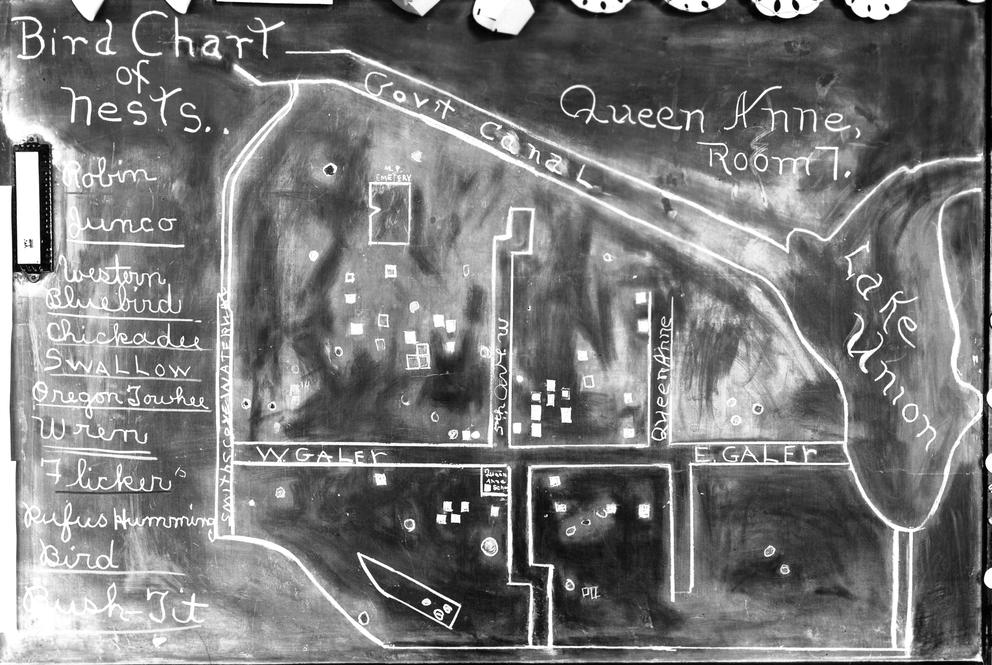Today she would be an influencer, and one with serious credentials. Pollock was a pioneer educator in Seattle. She taught in one-room schools in the 1880s, and by the turn of the century she was appointed principal of Queen Anne grade school, the first female principal in a graded Seattle public school. Pollock was well-educated herself — in addition to her teacher’s certificate, she was a graduate of Stanford University (Phi Beta Kappa) and got her master’s from the University of Washington.
In the early 1900s, her school and its neighborhood were growing. Most children at the time wouldn’t advance much beyond fourth grade, so kids had to learn “the three Rs” quickly: readin’, ’ritin’ and ’rithmetic. But at Pollock’s school you could add a B to the Rs: for birds. Pollock wanted her urban students to get out and study local nature. Birds attuned you to the environment. A bird-friendly city was a better city, period.
So classes at the school took this to heart. Students went on field trips around Queen Anne to identify and map bird nests. They went birdwatching at Mt. Pleasant, the local cemetery. They read bird poetry and studied the habits of birds: hummingbirds, robins, flickers, wrens and juncos — even Western bluebirds which, back in the early 1900s, still nested in the city. You didn’t have fancy binoculars in those days — but you might use a pair of mom’s opera glasses.
And as Seattle grew, she wanted to build more housing — for birds. Fourth grade classes were assigned to build bird houses that were friendly to local species. The kids turned out all kinds: box houses, duplexes, bungalows and log cabins fit for nesting songbirds.
After some 18 years at the Queen Anne school, Pollock shipped out to do her bit in WWI working with the Red Cross, the YMCA and the U.S. Army in France, schooling soldiers in citizenship. She even managed to do a little birdwatching “over there,” befriending, for example, some nightingales.
When she returned to Seattle, she turned from school administration to civic activism. The city became her bird classroom. She spoke about birds to civic groups and taught ornithology at the University of Washington. She borrowed stuffed bird specimens and played recordings of bird songs for her talks. She took youth groups like Girl Scouts and Campfire Girls into the mountains and forests for birdwatching. Newspapers nicknamed her Seattle’s “Bird Lady,” but she called herself “Bird Woman.”
There were some large tomes about Washington birds — like the two-volume set by Dawson & Bowles published in 1909. Not exactly a reference guide you’d lug into the field, but with excellent color plates. She wrote two birding books of her own: first, Excursions About Birdland in 1924, a pocket-sized guide to Western birds printed in green ink and meant to be read before the campfire, but also containing key information for novice birders.
She also wrote a series of essays about her experiences with young people and nature, which she collected into an illustrated book in 1930, Wings Over Land and Sea. The book, she wrote, “seeks to initiate its readers into that increasing number of people who are seeking their pleasure in the study of nature and her feathered citizens.”
Pollock was an educator of her times. Historian Margaret Gribskov has described her as having all the qualities the school district looked for, including: “decorous professionalism, American ancestry, patriotism, unfailing energy, Protestant beliefs, formal training, a liberal education, and spinsterhood.” Seattle’s female teachers had to be single in Pollock’s day.
Back then, schools were seen as the frontlines of turning an increasingly diverse population into assimilated Americans. Pollock was on board with that. If she saw birds as “feathered citizens,” she also wanted to shape a responsible and patriotic citizenry, albeit a mostly white one. The groups she spoke to were largely segregated. She helped found the Seattle Audubon Society chapter, which has recently changed its name due to John James Audubon’s enslavement of Black people. The Seattle group now calls itself Birds Connect Seattle and hopes to diversify the white-dominated birding community.
Miss Pollock made a mark beyond birds. She helped found a national organization of women in educational administration. She also co-founded a home for retired teachers who, as a group, had no pensions and were chronically underpaid. That became Ida Culver House. Pollock retired there herself. She died in 1938 doing what she loved, felled by a fatal stroke while birdwatching with a friend on Vashon Island.
Gribskov laments that Pollock has been mostly “lost to history both because she was female and because she was an educator.” Historians, she observed, have often overlooked women teachers and community activities in their grand narratives — even if such things are foundational.
The historic West Queen Anne school still stands, but has been converted to high-end condos. Teachers like Pollock were among the first residents in Queen Anne Hill’s apartment boom of the early 20th century. Today, many teachers can’t afford to live in the city.
Birds aren’t the only ones with a housing problem.




